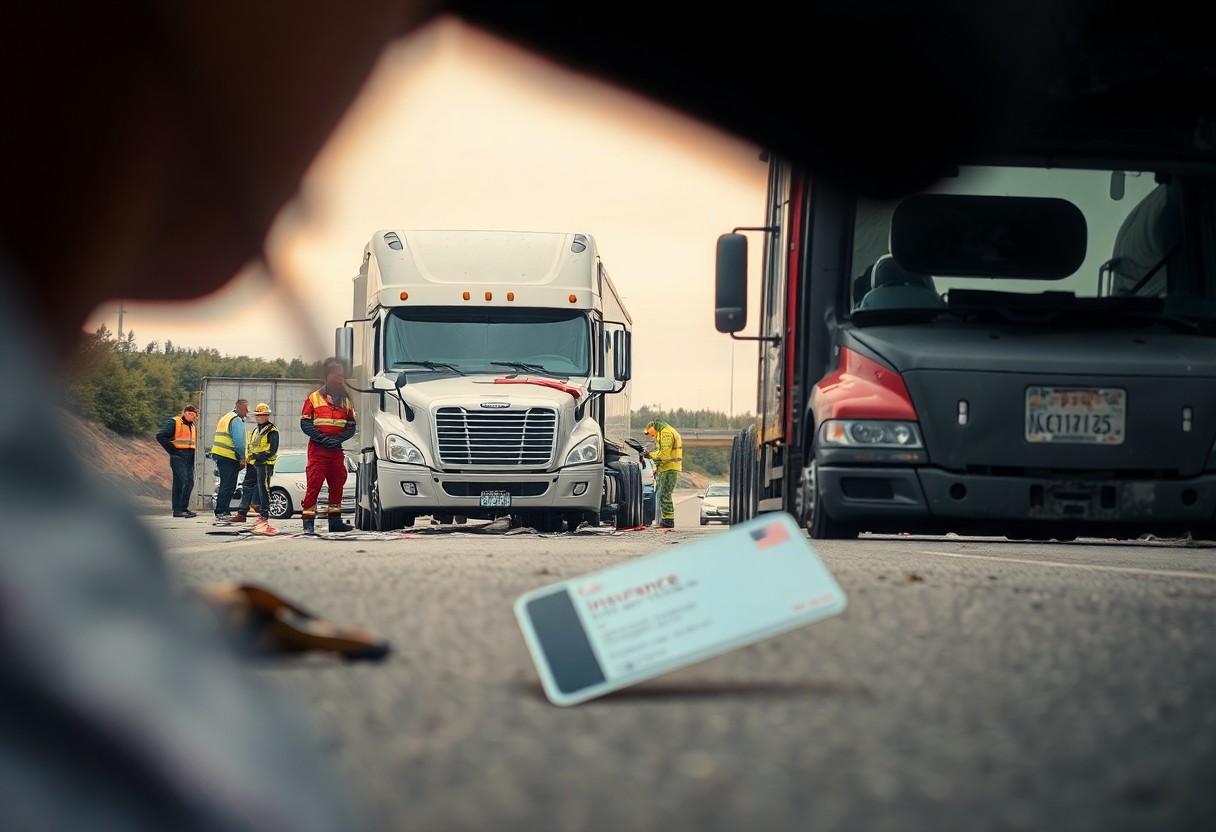There’s a significant risk on the roads when you share your commute with large trucks. These vehicles have larger blind spots and require greater stopping distances, making it important for you to exercise extra caution while driving near them. Collisions involving trucks can lead to severe injuries and property damage, so being aware of your surroundings is imperative. By maintaining a safe distance, using signals for lane changes, and avoiding sudden stops, you can help ensure your safety and the safety of everyone on the road.
Understanding the Size and Weight of Trucks
A truck’s sheer size and weight significantly affect your driving experience on Huntsville roads. These large vehicles can weigh up to 80,000 pounds and occupy much more space than standard passenger cars. It is imperative for you to acknowledge that this additional mass does not just impact maneuverability but also the dynamics of traffic flow and your own safety. By understanding these factors, you can make better decisions when navigating around trucks, ensuring safer driving for everyone involved.
The Impact of Truck Size on Visibility
About the size of a truck can severely impede visibility for you as a driver. Trucks have larger blind spots, often extending to the sides and back, which can make it difficult for truck drivers to see smaller vehicles like yours. Positioning your vehicle too close to a truck can also lead to you becoming hidden from their view entirely. As you drive near trucks, always ensure you’re in the proper sightline and maintain a safe distance to enhance your visibility and safety.
Weight Differences and Stopping Distances
Size and weight play a significant role in how long it takes a vehicle to stop. A truck’s larger mass means it requires a much longer stopping distance compared to your car. For example, at highway speeds, a fully loaded truck can take over 500 feet to come to a complete stop, whereas your vehicle may need only about 300 feet. Because of this, it is imperative for you to keep a safe following distance when driving behind trucks, allowing them ample space in case sudden stops occur.
Weight makes all the difference when it comes to stopping distances. A heavily loaded truck not only weighs more, but its enormous inertia means it cannot stop as quickly as you might expect. This disparity can lead to dangerous situations if you’re too close, as you may not have enough time to react if the truck suddenly brakes. Make it a habit to stay well back, especially on inclines or in heavy traffic, so both you and the truck driver can maintain safer road conditions.
Common Truck Blind Spots
Even well-trained truck drivers have limited visibility, which is why understanding truck blind spots is important. These blind spots, often called ‘No Zones’, are areas around a truck where your vehicle may not be visible to the driver. Typically, they are located directly behind the trailer, to the left and right sides, and in front of the truck. Being aware of these areas helps you navigate safely around large vehicles in Huntsville’s busy roads.
Identifying Blind Spots Around Trucks
At the front of a truck, you might find a significant blind spot as it extends several feet outward. On the sides, the blind spots can be wider, encompassing the area up to two lanes over. Behind the trailer, there’s a large blind zone where smaller vehicles can disappear from the driver’s view, making it difficult for them to see your presence. Always approach trucks with caution and stay aware of these blind spots to enhance your safety.
Safe Driving Practices Near Blind Spots
Across the road, keeping your distance from trucks is vital. Try to avoid lingering in a truck’s blind spots; if you can’t see the driver in the side mirror, they likely can’t see you either. Be particularly careful when changing lanes, and ensure there’s enough space to pass safely. Always signal your intentions well in advance to allow the truck driver to react accordingly.
Plus, when driving near trucks, it’s important to maintain a safe following distance to give yourself more reaction time. If a truck makes a sudden stop, you’ll want plenty of room to avoid a collision. Another positive tip is to avoid distractions while driving near large vehicles. Keeping your focus will help you gauge the truck’s speed and direction accurately, ensuring a safer interaction on the road. By being proactive and cautious, you can significantly reduce your risk when sharing the road with trucks.
Traffic Patterns Involving Trucks
Assuming you navigate Huntsville’s roads daily, being aware of the unique traffic patterns involving trucks is important for your safety. Trucks often have longer stopping distances and larger blind spots, which can significantly affect the flow of traffic. In residential areas and business districts, their presence may cause unexpected slowdowns or stops. Understanding how trucks integrate into various traffic conditions will help you make better driving decisions.
Merging and Lane Changes
About half of all truck accidents occur during merging and lane changes. As you approach a truck, always check your mirrors and blind spots before changing lanes, especially since trucks require more space to maneuver. Ensure you provide adequate space for trucks when merging onto highways, as they can be slower to accelerate compared to smaller vehicles.
Turn Signals and Truck Maneuvers
Against common perception, truck drivers often rely heavily on turn signals to communicate with you. Misunderstandings can arise when drivers fail to notice these signals, leading to unsafe conditions on the road. Always maintain a safe distance and be vigilant when you see a truck indicating a turn.
Due to the sheer size and weight of trucks, you should pay close attention to turn signals and truck maneuvers. Trucks need more time and space to complete turns, often requiring a wider arc that can spill over into adjacent lanes. If you see a truck signaling, give it ample space and prepare for potential lane encroachments. Adapting your driving behavior to account for their size and intentions not only ensures your safety but also helps maintain smoother traffic flow.
Weather Conditions and Truck Driving
Unlike passenger vehicles, trucks are significantly affected by adverse weather conditions. The sheer size and weight of trucks make them more challenging to maneuver during rain, snow, or fog. In Huntsville, unpredictable weather can lead to hazardous driving situations, increasing the likelihood of accidents. Being aware of these conditions is vital for both truckers and passenger vehicle drivers to prevent dangerous encounters on the road.
How Weather Affects Truck Operations
With changing weather patterns, truck operations can be severely impacted. Rain can reduce visibility and increase stopping distances, while snow and ice make roads slick and treacherous. These factors lead to longer reaction times and can cause trucks to sway or jackknife, posing risks not only to truck drivers but also to nearby drivers. Understanding these impacts is imperative for safe travel on Huntsville’s roadways.
Tips for Driving Safely in Adverse Conditions
To ensure your safety while driving near trucks in adverse weather conditions, consider these tips:
- Maintain a safe following distance to allow for longer stopping times.
- Use your headlights in low visibility conditions, such as rain or fog.
- Adjust your speed according to the road conditions, slowing down when needed.
- Avoid sudden movements that can startle truck drivers.
Perceiving the challenges that come with driving near trucks in poor weather can help you navigate safely.
Indeed, being cautious around trucks in adverse weather is imperative. Consider the following additional tips for enhancing your safety:
- Keep your windows clear by using defrosters and wipers effectively.
- Stay updated on weather conditions to plan your route accordingly.
- Be mindful of the truck’s blind spots, especially in inclement weather.
- Avoid distractions to keep full focus on the road ahead.
Perceiving the importance of these tips can significantly reduce risks associated with driving near trucks in unfavorable weather conditions.
Legal Responsibilities and Driver Awareness
After understanding the dynamics of driving around large trucks, you must recognize the legal responsibilities that come with it. Being aware of your surroundings and making prudent decisions can significantly reduce the risk of accidents. When operating near trucks, it’s crucial to be mindful of their blind spots and stopping distances, as failing to do so can lead to severe consequences for you and others on the road.
Understanding Right-of-Way with Trucks
Around large trucks, you need to grasp how right-of-way laws apply. Trucks require more space and time to maneuver than smaller vehicles, meaning it’s crucial to yield appropriately. Ignoring these rules not only endangers everyone on the road but can also result in legal repercussions if an accident occurs.
Legal Consequences of Accidents Involving Trucks
Across roadways, accidents involving trucks can have serious legal ramifications. You could be held liable for damages, which may include hefty fines, insurance rate hikes, or even civil lawsuits if you are determined to be at fault. Understanding these potential outcomes can help you make better decisions on the road.
Further complicating matters, accidents with trucks can bring about significant financial burdens—from medical expenses to vehicle repairs and potential loss of income. Insurance claims can become intricate due to legal disputes over fault, particularly as trucking companies may involve their own legal teams. You must ensure that your driving behavior is not only safe but compliant with your local regulations to minimize the risk of facing such severe consequences.

Educational Resources for Drivers
Your awareness and knowledge of road safety can make a significant difference when navigating around trucks. Fortunately, there are various educational resources available that can enhance your driving skills and help you understand the unique challenges trucks present on the road. By taking advantage of these resources, you can become a more confident and responsible driver, ensuring a safer driving environment for everyone.
Defensive Driving Courses
Before you hit the road, consider enrolling in a defensive driving course. These programs teach you imperative skills to anticipate potential hazards and react appropriately, especially when driving near large trucks. By honing these skills, you can significantly reduce the risk of accidents and improve your overall driving proficiency.
Local Workshops and Training Programs
With various local workshops and training programs available, you have multiple opportunities to enhance your driving education. Many organizations host events that focus on improving safety around large vehicles, particularly trucks. Through hands-on instruction and interactive sessions, you can engage with knowledgeable instructors who provide valuable insights and real-world scenarios.
Also, participating in these workshops can help you gain practical tips on maintaining safe following distances, recognizing blind spots, and adopting better communication techniques with truck drivers. The more you engage with community resources, the more you familiarize yourself with the complexities of sharing the road with larger vehicles, ultimately leading to a safer driving experience for everyone involved.
To wrap up
Ultimately, being cautious around trucks while driving in Huntsville is necessary for your safety and the safety of others. Large vehicles have significant blind spots, require longer stopping distances, and can maneuver differently than cars. By staying aware of these factors and adjusting your driving habits – such as giving trucks ample space and avoiding sudden lane changes – you can effectively reduce the risks associated with sharing the road with them. Prioritizing this caution will help ensure a safer driving experience for everyone involved.



















